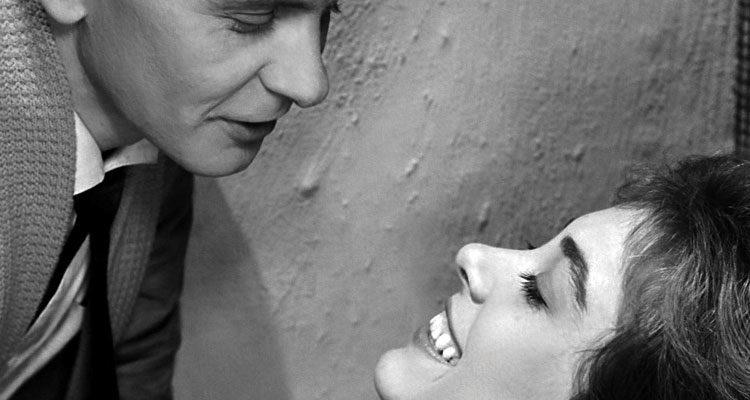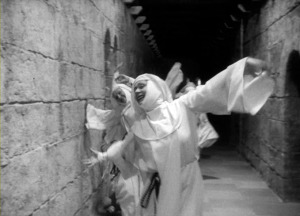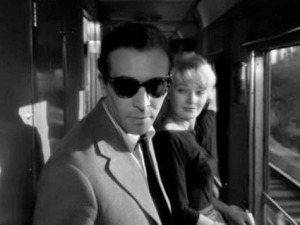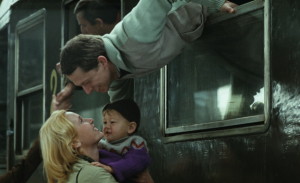Week one of Martin Scorsese Presents: Masterpieces of Polish Cinema, the OKCMOA’s sixteen film survey of the exceedingly ample Eastern European cinema from the Polish Thaw of the late 1950’s to the fall of Communism thirty years later, featured an especially large concentration of revelations for this programmer and writer. Even the Academy-celebrated Andrezj Wajda (Ashes and Diamonds, Man of Iron) managed to surprise with Innocent Sorcerers (1960), a desperately charming and especially archetypal example of new wave-style filmmaking, produced in exact parallel to France’s more famous nouvelle vague. Innocent Sorcerers, which was written by Jerzy Skolimowski (Moonlighting) and Jerzy Andrzejewski, opens with a gesture of artistic self-consciousness (or self-reflexivity) that is much more associated with French film practices of the post-1959 era than it is with the preceding Polish Film School: we see the film’s credits graphic on a pair of urban billboards. This modernist self-awareness continues to manifest itself as the film progress, both in added references to the film’s title, and also in the document conceived by the picture’s two alluring romantic leads, Bazyli (Tadeusz Lomnicki) and Pelagia (Krystyna Stypulkowska). Finding themselves alone and together for the first time in Bazyli’s apartment, Pelagia creates an outline of the night to follow, a plot to which they will adhere judiciously as their very late night becomes dewy early morning. In the meantime, Wajda hints, however lightly, at a feeling of youthful alienation, which will come to combine with the work’s collectivist spirit to mark it as a Polish paradigm for Europe’s then burgeoning youth cinema, its many new waves.
Innocent Sorcerers also glances back toward Italian Neorealism, its more immediate, 1940’s-era source, through its devotion to ‘dead time’ or to those poetical passages that only minimally and sporadically advance the film’s narrative. The extended representation of Bazyli’s morning routine – he spends a few minutes shaving with an electric razor as he navigates his small apartment – provides an especially notable, and notably inert instance, one that is worthy of Neorealism axiom Vittorio De Sica himself (see Umberto D.). Then there is Bazyli and Pelagia’s matchbox flipping game, where the loser is required to remove an article of clothing. (The promise of nudity is also teased in Pelagia’s marvelous, clothesline/toga burlesque.) In this surprisingly suspenseful and uncomfortably sexy interval of arrested narration, Wajda manages to infuse his film art with all the sexual anticipation and anxiety that the film’s first-night-together story-line implies. The couple’s sensual, psychological dance ultimately will yield an emotional intimacy and depth of feeling that the viewer is made to feel with enormous urgency. Wajda’s emotional manipulations, combined with the intelligence and nuance with which he and his screenwriters have conceived of Pelagia’s ‘innocent sorcerer,’ not to mention the work done by the two leads themselves, make this one of the director’s (and the global new wave era’s) more affecting films.
An even greater surprise for this writer and Masterpieces of Polish Cinema curator, to the degree that nothing by Wajda can be wholly unexpected at this point, has been the work of fellow Polish Film School director Jerzy Kawalerowicz. Skilled in a variety of genres, including grand Egyptian spectacle – his Pharaoh (1966) bests anything Cecil B. DeMille made in the postwar period, and was one of the absolute highlights of week one – Kawalerowicz’s Thaw-era work is unified by an exceptional compositional capacity and, even by the standards of the Polish Film School, a pervasive eroticism. Mother Joan of the Angels (1961, pictured), a Cannes jury prize-winner, provides a particularly strong – and daring – example of Kawalerowicz’s lusty idiom, in its hothouse story of a possessed group of nuns and the overmatched exorcist who is dispatched to their remote monastery. By frequently adopting a bird’s-eye vantage, Kawalerowicz’s camera often achieves a quasi-abstraction, whether he is presenting a doomed humanity in the film’s veritably lunar landscape or whether instead he is accentuating the graphic possibilities of the nun’s costuming as they lie flat on the chapel’s stone floor. In the film’s more theatrical exchanges, Kawalerowicz’s two-shot, multi-figural framings take on a psychological dimension, as these compositions succeed in demonstrating how the filmmaker’s characters think about one another in principally visual terms.
Kawalerowicz’s sense of the abstract extends to the isolated close-ups that accentuate Mother Joan of the Angel’s principle concern, performance. This subject matter, in some sense, is intrinsic for the modern, more or less secular spectator, who is made to wonder whether Mother Joan (Lucyna Winnicka) is truly possessed by evil spirits or whether instead she is performing for her beholders. The very fact that our actress, Kawalerowicz’s real-life wife Winnicka, is herself capable of such an extraordinary, out-of-body performance only adds to the film’s fundamental, very intriguing and ultimately unresolved ambiguity – an ambiguity, I should add, that is productive of the entire exorcist genre in the secular modern era. The fact that this behavior can be mimicked, in other words, casts doubt on the veracity of demonic possession, from the modern perspective at least.
The final week one revelation of which I would like to make further mention is Kawalerowicz’s outstanding Night Train (1959), or the director’s masterclass in staging action in the radically constricted space of an overnight passenger train. Kawalerowicz’s camera is present, just below eye-level, as the train’s societal cross-segment snake through the over-populated corridors, and when his two leads, Marta (Winnicka, again) and Jerzy (Leon Niemczyk), find themselves in the forced intimacy of a shared sleeper. With a jazz theme that reoccurs with each of their increasingly affectionate interactions, Kawalerowicz’s film would seem to be following an arc similar to Innocent Sorcerers’ until Jerzy’s sudden confession (that his wife is waiting at the final stop) brings about the film’s melancholic, unrequited conclusion.
The film’s low-key close corresponds to both the director’s more tragic directorial worldview and also to the dark undercurrent of violence that surfaces with the mob’s capture of the picture’s murder suspect. (Night Train is a romantic melodrama, ensemble societal portrait and noir-style suspense all at once.) In this richly evocative set-piece, the film’s jazz scoring suddenly goes silent as the passengers chase after the fugitive, flailing through misty haystacks and overgrown gravestones as they chase their target. Reaching him, Kawalerowicz’s camera moves back to its deterministic overhead view, observing as the mob bullies their pathetic captive, who begins to take on the mannered appearance of a silent performer, in an approximate reference to the work Fritz Lang (Dr. Mabuse, M, etc.). Here, it becomes clear that there is something much more sinister at work in this affecting piece of pop art-cinema, something that will be hinted at further in the film’s passing reference to Buchenwald. A train is never just a train in postwar Poland.
If week one was rich in new discoveries for this writer, week two will feature a number of previous favorites, including Krzysztof Zanussi’s wryly comedic dissection of academic ambition, Camouflage (1977; screening Friday, November 14 at 5:30 p.m.); Zanussi’s friend and collaborator Krzysztof Kieslowski’s Blind Chance (1981/1987; screening Sunday, November 16 at 2 p.m.), which quite conceivably is the greatest of all forking path narratives, and one of the truly standout films in Polish history; and Kieslowski’s A Short Film about Killing (1988; screening Sunday, November 16 at 5 p.m.), a sub-ninety minute expansion of the director’s stirring look at the Sixth Commandment. In between, there are more opportunities for personal discovery or re-acquaintance, whether it is the captivating all-time box office juggernaut Black Cross (1960, Aleksander Ford; screening Saturday, November 15 at 2 p.m.) or Andrezj Munk’s classic Eroica (1958; screening Saturday,November 15 at 5:30 p.m.), which cynically slices the mythic concept of Polish heroism. For a complete list of films, dates and times, please visit okcmoa.com/see/films.













